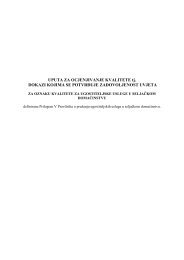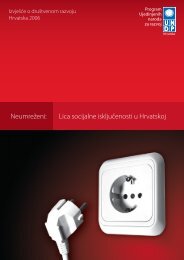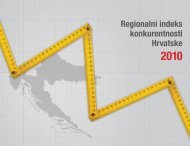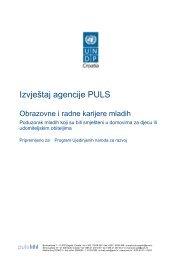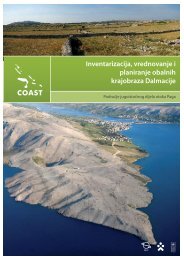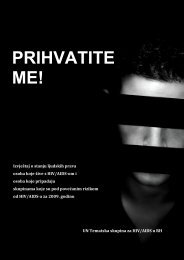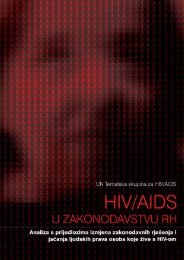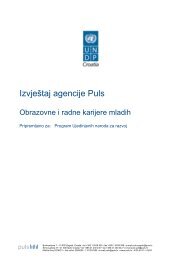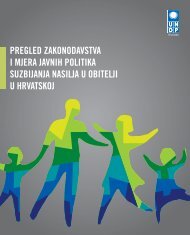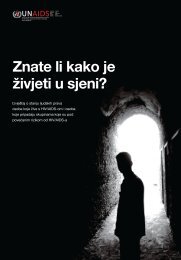WEB engleska verzija end.indd - UNDP Croatia
WEB engleska verzija end.indd - UNDP Croatia
WEB engleska verzija end.indd - UNDP Croatia
- No tags were found...
Create successful ePaper yourself
Turn your PDF publications into a flip-book with our unique Google optimized e-Paper software.
THE SOCIALLY EXCLUDEDCHAPTER 3obstacles preventing the disabled from benefitingfrom the healthcare system; the largest problemwould seem to be the quantity and replenishment ofprosthetic devices.One in five <strong>Croatia</strong>n citizens (21.1%) view the quality oftheir healthcare to be low, 82 noting excessive waitingperiods, high costs to visit doctors, and a lack of informationabout options regarding their health. Medicalinstitutions used to place individuals with disabilitiesat the front of patient triages, however, today therewould appear to be no such formal triage procedurewhich grants special status to the disabled.The problem of physical barriers and inadequateequipment for the disabled in health institutions isreduced with each new investment, however thereare still problems with public bathrooms not providingadequate support. G<strong>end</strong>er too has becomean issue when modernizing health services for thedisabled. Men are not overly affected by deficienciesin the system, however for disabled women requiringgynaecological examinations the situation is lessthan satisfactory. 83 Another problem is the lack ofattention in the health services paid to registrationforms for the <strong>Croatia</strong>n Register of Persons with Disability,which can compromise the quality of the dataon people with disabilities.3.5.4 Access to EducationMany students with disabilities are unable to att<strong>end</strong>primary school within their community due to a lackof proper infrastructure to accommodate their needs.Often these children are sent to schools away fromtheir homes, or to special institutions. Consequently,the children are separated from their families andfrom their social networks. This diminishes the chanceof gaining employment in their home community, orof developing quality inclusion. In 2005, at the initiativeof the Ministry of the Ministry of Science, Educationand Sport, and in partnership with the <strong>Croatia</strong>nUnion of Physically Disabled Persons Associations,an assessment of necessary structural adjustmentsneeded in schools to accommodate disabled studentswas conducted.In the last several years, the associations of parentsand persons with disability have been applyingstrong pressure, demanding that the problems ofaccessibility be resolved, 84 and that problems concerningschooling be settled in cooperation withthe Ministry, in agreement with the local authorities.However, new schools are still being built withoutconsideration for access for the disabled, and thosewith the proper resources (such as elevators) fail tomaintain them. Despite these drawbacks, there are28 schools in <strong>Croatia</strong> with elevators, 127 restroomshave been adapted to the needs of the disabled, 303access ramps have been constructed, 1,196 (72%)entrances have been modified to a minimum widthof 90 cm, and 561 (34%) have reduced entrance steps’inclinations and modified safety rails. 85Accessibility means that all <strong>Croatia</strong>n schools mustallow all students to att<strong>end</strong> regular classes, withinan appropriate distance from their residence, regardlessof any physical impairment. There are also lesstangible barriers that are faced by children with disabilities,which include:- Inadequately educated professional staff;- Lack of team work;- Absence of a network for family support (transport,personal assistant, temporary care for the child,assistance in the house, and other);- Lack of technical equipment in public andeducational institutions;- Deficiencies in developing social skills and selfcareskills in line with the abilities of disabledpersons; and- Insufficient social acceptance of diversities, thatis, insufficient understanding and acceptance ofdiversities in the community.82 <strong>UNDP</strong> (2006). Research on social exclusion in <strong>Croatia</strong>: Quality of Life and the risk of social exclusion. <strong>UNDP</strong>, Zagreb, <strong>Croatia</strong>83 Five gynaecological offices for women with disabilities have been adapted for them in Zagreb (2), Rijeka, Split and Osijek; www.mzss.hr84 The association of persons with physical disabilities helped build an elevator in a primary school in Velika Gorica in 1999, and alsocontributed to the adaptation of 19 rooms for the needs of persons with physical disabilities in the Student Dormitory Cvjetno Naselje in2000.85 Analysis of accessibility in primary schools in the Republic of <strong>Croatia</strong> 2006, THE HSUTI in co-operation with the Ministry of Science,Education and Sports.67



